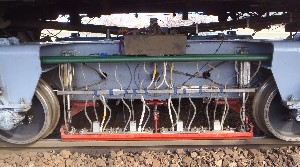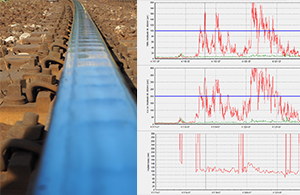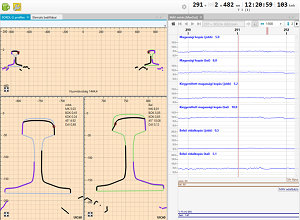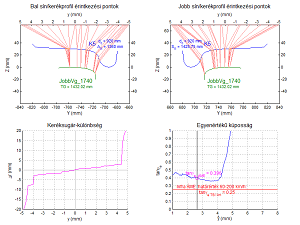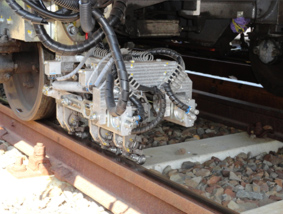The train consist of three units; two five-axled motor wagons and a four-axled measuring car between the motors.
The train is suitable for testing rails and revealing rail defects by means of ultrasonic material testing method. The train allows the non-contacting measurement of rail cross profiles and non-contacting magnetic measurement of corrugation.
Parts of the measuring system:
Features:
Detection of transversial and longitudinal material defects of rails and welding by ultrasonic impulse-echo method. Determination, evaluation and archiving of defects by sections and preparation of test reports.
Technical parameters:
| number of ultrasonic channels: | 10 |
| event channels: | 12 |
| radiation angles (for both rails): | 0° ±2° 70°±2° back and forth 45°±2° back and forth |
| adjustable repetation frequency: | 1 - 5 KHz |
| adjustable travel speed: | 100 km/h max. |
| max testing speed: | 50 km/h |
Features:
Transmitters are built into a measuring bogie, which are the base of the measurement, supply electric signal proportional to the rail and measuring probe distance. The measurement control computer receives digitalized electric signals and way marks and saves them onto a hard disk.
The data managing software calculates and displays the size of local faults as well as the frequency spectrum of the results.
Technical parameters:
| guiding detectors over the running surface of rails: | 5mm |
| sampling: | 16 kHz/channel |
| max. testing speed: | 50 km/h (6mm longitudinal sampling) |
Services:
Non-contact measurement of rail cross profiles independently of speed by means of detector heads guided above the rails and comparison of results with the original profile.
The sytem records location identifying data and profile characteristics:
- rail types
- gauge
- rail wear
- wear angle
- cant of rail
- rail classification
Prepares database, displays rail profiles and all corresponding measurement data.
Technical information:
| number of records: | 7,5 image/sec |
| measurement accuracy: | 0,25 mm |
In each measured profile 400 to 500 points are recorded. Data of any rail type can be entered into the system.
The significance of the equivalent conicity
The equivalent conicity is a quantity characteristic how the railway wheel-set and the rails work together. From its value we can deduce the probability of develping a running instability. We talk about running instability when the wheel-set or bogie does a perpetual high frequency sinuous movement. The running stability is mostly influenced by the forming of the vehicle's bogie but the role of the track can't be neglected. This role can be described with the value of the equivalent conicity.
Operation of the system
The measuring and the evaluation is done according to the 'Technical regulations for interoperability' and to the European standards (MSZ EN 15302:2008). The system uses the data of the rail profile system on the rail diagnostic train (together with the gauge) and from these parameters the rail profiles can be drawn in any cross-section along the track.
The other basic data, the form of the inspected wheel-set, has to be entered with coordinates. The software associates every track cross-section with the wheel-set and determines the value of the equivalent conicity in the given point. As the sinuous movement extends along the whole length of the track, according to the standard the result of the measuring is the average of each cross-section for every 100 m. In turnouts and in curves smaller than 10 000 m the results can be disregarded since in those places other attributes determines the vehicle's run.
Services of the system
- importing .txt files, which contains the parameters of the wheel-set
- besides using the measuring of the rail diagnostic train it is possible to import rail cross-sections with coordinates
- calculating unique value, average value and standard deviation for equivalent conicity
- exporting results in .txt format
- displaying database channels containing infrastructure data
- displaying and exporting measured rail profiles with coordinates
- exporting graphs as pictures
- changing language
- detailed analysis of the cross-section drawing the possible wheel-rail contact points
- calculation settings: alignment steps, cross-amplitude, sliding average length, filters
- visualization settings (graphs, steps)
Frame
- max. speed while inspection: 80 km/h
- weight (one frame): 58 kg
- dimensions (inspection position): 810 x 340 x 500 mm
Probes:
- installed: 4 probes/rail
- frequency range: 50 – 200 kHz
- default gap: 1,0 mm
- lift-off range: 0,50 – 3,0 mm
- crack depth range: 0,30 – 2,7 mm
- max. density (according to hardware): 110 – 165 HC/m
- max. density (according to software): 220 – 330 HC/m
Services:
Eddy-current system can detect head-checks at the rail surface. Main parameters: crack depth and crack(piece)/meter. The measure is documented by a report.



